
Miso is a traditional Japanese seasoning. It is a thick paste produced by fermenting soybeans with salt and kōji and sometimes rice, barley, seaweed, or other ingredients. It is used for sauces and spreads, pickling vegetables, fish, or meats, and mixing with dashi soup stock to serve as miso soup, a Japanese culinary staple. Miso is high in protein and rich in vitamins and minerals, and it played an important nutritional role in feudal Japan. Miso is still widely used in both traditional and modern cooking in Japan and has been gaining worldwide interest.
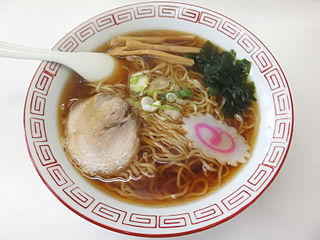
Ramen is a Japanese noodle dish. It consists of Chinese-style wheat noodles served in a broth. Common flavors are soy sauce and miso, with typical toppings including sliced pork, nori, menma, and scallions. Ramen has its roots in Chinese noodle dishes and is a part of Japanese Chinese cuisine. Nearly every region in Japan has its own variation of ramen, such as the tonkotsu ramen of Kyushu and the miso ramen of Hokkaido.
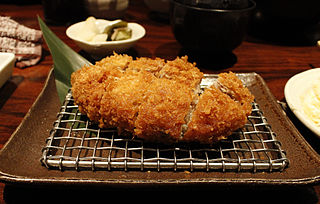
Tonkatsu is a Japanese dish that consists of a breaded, deep-fried pork cutlet. It involves coating slices of pork with panko, and then frying them in oil. The two main types are fillet and loin. Tonkatsu is also the basis of other dishes such as katsukarē and katsudon.

In cooking, a sauce is a liquid, cream, or semi-solid food, served on or used in preparing other foods. Most sauces are not normally consumed by themselves; they add flavor, texture, and visual appeal to a dish. Sauce is a French word probably from the post-classical Latin salsa, derived from the classical salsus 'salted'. Possibly the oldest recorded European sauce is garum, the fish sauce used by the Ancient Romans, while doubanjiang, the Chinese soy bean paste is mentioned in Rites of Zhou 20.

Oden is a type of nabemono consisting of several ingredients such as boiled eggs, daikon or konjac, and processed fishcakes stewed in a light, soy-flavored dashi broth.
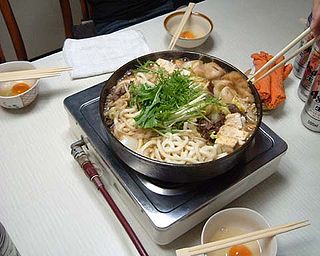
Nabemono, or simply nabe, is a variety of Japanese hot pot dishes, also known as one pot dishes and "things in a pot".

Miso soup is a traditional Japanese soup consisting of miso paste mixed with a dashi stock. Optional ingredients based on region and season may be added, such as wakame, tofu, negi, abura-age, mushrooms, etc. Along with suimono, miso soup is considered to be one of the two basic soup types of Japanese cuisine. It is a representative of soup dishes served with rice.

Onigiri, also known as omusubi (お結び) or nigirimeshi (握り飯), is a Japanese rice ball made from white rice. It is usually formed into triangular or cylindrical shapes, and wrapped in nori (seaweed). Onigiri traditionally have sour or salty fillings such as umeboshi, salted salmon, katsuobushi, kombu, tarako or mentaiko, or takanazuke. Because it is easily portable and eaten by hand, onigiri has been used as portable food or bento from ancient times to the present day. Originally, it was used as a way to use and store left-over rice, but it later became a regular meal. Many Japanese convenience stores and supermarkets stock onigiri with various fillings and flavors. It has become so mainstream that it is even served in izakayas and sit-down restaurants. There are even specialized shops which only sell onigiri to take out. Due to the popularity of this trend in Japan, onigiri has become a popular staple in Japanese restaurants worldwide.
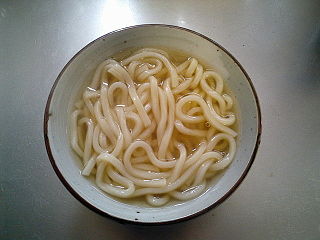
Udon is a thick noodle made from wheat flour, used in Japanese cuisine. There are a variety of ways it is prepared and served. Its simplest form is in a soup as kake udon with a mild broth called kakejiru made from dashi, soy sauce, and mirin. It is usually topped with thinly chopped scallions. Other common toppings include prawn tempura, kakiage, abura-age, kamaboko, and shichimi spice added to taste.

Okazaki is a city located in Aichi Prefecture, Japan. As of 1 October 2019, the city had an estimated population of 386,999 in 164,087 households, and a population density of 999 persons per km². The total area of the city was 387.20 km2 (149.50 sq mi).
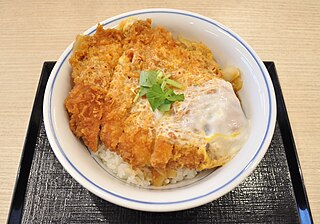
Katsudon is a popular Japanese food, a bowl of rice topped with a deep-fried breaded pork cutlet, egg, vegetables, and condiments.

Karashi, also known as Oni Karashi is a type of mustard used as a condiment or as a seasoning in Japanese cuisine. Karashi is made from the crushed seeds of Brassica juncea and is usually sold in either powder or paste form. Karashi in powder form is prepared by mixing with lukewarm water to a paste and leaving it covered for a few minutes.

Japanese cuisine has a vast array of regional specialities known as kyōdo ryōri (郷土料理) in Japanese, many of them originating from dishes prepared using local ingredients and traditional recipes.

In Japan, it is customary to serve alcoholic drinks with snacks called sakana, shukō, or otsumami (お摘み). These are usually quite salty and served in relatively small portions. Sakana are usually more substantial than tapas, although they are not considered a meal since they are not accompanied by rice. Traditionally, the Japanese regarded sake, which is made from rice, as a substitute for white rice served in a standard Japanese meal, and as a result some Japanese do not eat rice and drink alcohol simultaneously.

Okazakikōen-mae Station is a railway station in the city of Okazaki, Aichi, Japan, operated by Meitetsu.

Yuzu koshō is a type of Japanese seasoning. It is a paste made from chili peppers, yuzu peel and salt, which is then allowed to ferment. It is usually used as a condiment for nabemono dishes, miso soup, and sashimi. The most famous types of yuzu koshō come from Kyushu, where it is a local specialty.

Ginanggang, guinanggang, or ginang-gang is a snack food of grilled skewered bananas brushed with margarine and sprinkled with sugar. It originates from the island of Mindanao in the Philippines. It literally means "grilled" in Cebuano.

Pinaypay, also known as maruya, is a type of banana fritter from the Philippines. It is usually made from saba bananas. The most common variant is prepared by cutting bananas into thin slices on the sides and forming it into a fan-like shape, and coating it in batter and deep frying them. They are then sprinkled with sugar. Though not traditional, they may also be served with slices of jackfruit preserved in syrup or ice cream. Pinaypay are commonly sold as street food and food sellers at outdoor though they are also popular as home-made merienda snacks among Filipinos.

Kushikatsu (串カツ), also known as kushiage (串揚げ), is a Japanese dish of deep-fried skewered meat and vegetables. In Japanese, kushi (串) refers to the skewers used while katsu means a deep-fried cutlet of meat.
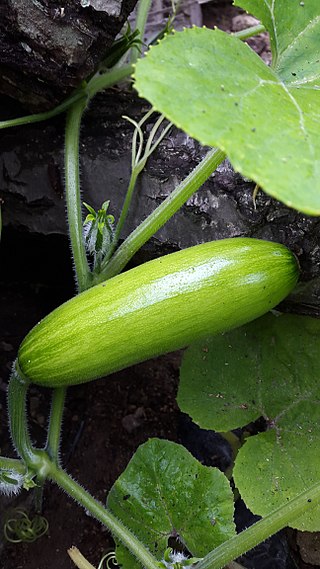
Aehobak, also called Korean zucchini or Korean courgette, is an edible, green to yellow-green summer squash. Although nearly all summer squashes are varieties of Cucurbita pepo, aehobak belongs to the species Cucurbita moschata. Commonly used in Korean cuisine, an aehobak has the shape of zucchini, but with thinner, smoother skin, and more delicate flesh. It is usually sold in shrink-wrapped plastic.





















